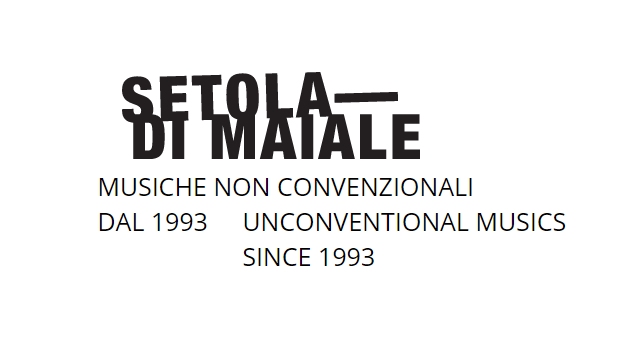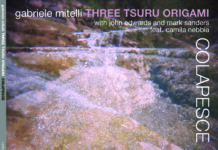Some thoughts about three new Setola di Maiale’s CDs:
–Massaria/Kneer/Hertenstein: The Absence of Zero
–Mario Cianca Trio: Komuso
–Donatello Pisanello: Mementi
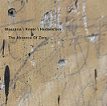 The Absence of Zero is the title of a long poem by Canadian poet R. Kolewe, published in 2021. The Absence of Zero is also the title of a November 2021 trio recording made in Berlin by guitarist Andrea Massaria, double bassist Meinrad Kneer, and drummer Joe Hertenstein, an international trio whose members are currently based in Trieste, Germany, and New York, respectively. What can these two different works, in very different media, have in common? Kolewe’s poem, inspired by relativity theory as well as the phenomenology of everyday life, is a meditation on the malleability of time and how we experience it. Massaria, Kneer, and Hertenstein’s music, created in the real-time crucible of free improvisation, is the record of how time is experienced in all its patchiness and plasticity when it is transposed into sound.
The Absence of Zero is the title of a long poem by Canadian poet R. Kolewe, published in 2021. The Absence of Zero is also the title of a November 2021 trio recording made in Berlin by guitarist Andrea Massaria, double bassist Meinrad Kneer, and drummer Joe Hertenstein, an international trio whose members are currently based in Trieste, Germany, and New York, respectively. What can these two different works, in very different media, have in common? Kolewe’s poem, inspired by relativity theory as well as the phenomenology of everyday life, is a meditation on the malleability of time and how we experience it. Massaria, Kneer, and Hertenstein’s music, created in the real-time crucible of free improvisation, is the record of how time is experienced in all its patchiness and plasticity when it is transposed into sound.
The sounds favored by the group over the course of these five untitled, texturally thick tracks are elastic—elastic both in their responses to each other and in relation to themselves. At the collective level, the three voices are in constant communication and mutual adjustment throughout, the pull of one counteracted by the push of another. Individually, each musician expands and contracts the boundaries alternately opening up and limiting his instrument’s range as it moves back and forth between conventional and unconventional soundworlds. Massaria trained as a classical guitarist before moving into jazz and free improvisation; here his spiky lines and broken rhythms reflect something of the dexterity of classical guitar technique while repositioning it at the outer limits of its musical potential, helped along by the use of various electronic effects. Kneer counters Massaria’s electronics with purely acoustic playing, leveraging extended techniques with fingers and bow to match Massaria abstraction-for-abstraction. Underneath it all Hertenstein free pulse drumming maintains a constant chatter of cymbals, snare, and tom toms, alluding to the kit’s conventional role rather than reprising it.
The last word can go to Kolewe’s The Absence of Zero, one of whose quatrains uncannily suggests something of what it is like to listen to Massaria, Kneer, and Hertenstein’s The Absence of Zero:
Uncertain if there are figures without boundaries,
leave pages blank, nothing uncovered
distance scattering error quantum error & so
beginning with unrecognized constellations
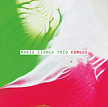 Komuso, by the Mario Cianca Trio, presents its tracks as honkyoku, a Japanese word meaning “original pieces.” The term was first applied to shakuhachi music collected in the 18th century by a group of Zen-interested masterless samurai, or ronin, calling themselves the “Lay Monks of the Non-Dual and None-ness”–the komuso of the album’s title. As its connection with Zen Buddhism betokens, this music had a primarily meditative function. The sounds, often slow-moving and static, were meant to foster the proper state of mind for gaining experiential insight into the metaphysical ground beyond being and non-being that Zen held to be foundational. To play music in this way was to engage in a discipline for which music was the vehicle rather than the endpoint. The Mario Cianca trio, consisting of Cianca on double bass, Luca Venitucci on accordion and objects, and Andrea Biondi on vibraphone, retains the spirit of honkyoku even as the three musicians update its sound with contemporary improvisational sensibilities married to advanced instrumental techniques.
Komuso, by the Mario Cianca Trio, presents its tracks as honkyoku, a Japanese word meaning “original pieces.” The term was first applied to shakuhachi music collected in the 18th century by a group of Zen-interested masterless samurai, or ronin, calling themselves the “Lay Monks of the Non-Dual and None-ness”–the komuso of the album’s title. As its connection with Zen Buddhism betokens, this music had a primarily meditative function. The sounds, often slow-moving and static, were meant to foster the proper state of mind for gaining experiential insight into the metaphysical ground beyond being and non-being that Zen held to be foundational. To play music in this way was to engage in a discipline for which music was the vehicle rather than the endpoint. The Mario Cianca trio, consisting of Cianca on double bass, Luca Venitucci on accordion and objects, and Andrea Biondi on vibraphone, retains the spirit of honkyoku even as the three musicians update its sound with contemporary improvisational sensibilities married to advanced instrumental techniques.
Although the music on Komuso has a meditative purport, it doesn’t remain in a stereotypically quiet or lulling register. The group’s sound moves along a dynamic range that surges and recedes in parallel with the pace and density of its musical activity, which at times can be shot through with a tense, nervous energy. Accordingly, Cianca, Venitucci, and Biondi don’t avoid harmonies or timbres drawn from the more astringent end of the musical spectrum. Cianca, for example, can very well play delicately bowed harmonics or tolling plucked notes left to linger and dissolve into open air. But then he can turn around andbow two microtonally opposed notes at once to create a disquieting beating effect, or can grind the bow against the strings for a raw, unpitched sound of pure grit. Similarly, Biondi alternates slowly shimmering tones rising and falling with a pleasant, cascading sonority with single notes hammered out with a relentless urgency. Venitucci is as present on objects as on accordion, contributing a rattling, scraping clangor in addition the latter’s sustained harmonies and swirl of notes.
Beauty may be incidental to what Komuso sets out to achieve, but it nevertheless is present, albeit in some of its more challenging guises. It isn’t the kind of beauty we might automatically think of in connection with the classically austere Zen aesthetic, but Cianca, Venitucci, and Biondi put it out there as if to say that this is reflective of the contemporary life we actually live, not of an ideal serenity that may or may not be discoverable beneath the noise and the business of the everyday.
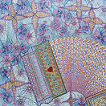 In Donatello Pisanello, two very different musical paths converge: the traditional and the experimental. On the one hand Pisanello, a composer of film scores as well as an electric and acoustic guitarist and accordionist, is involved with preserving and extending the traditional music of Salento in Puglia. On the other hand, he is conversant with jazz and some of the more arcane areas of psychedelia and modern electronics—traditions of their own, to be sure, but of a very untraditional kind. With Mementi Pisanello’s more contemporary influences come to the forefront, as he augments and manipulates the sounds of his diatonic accordion with electronic effects.
In Donatello Pisanello, two very different musical paths converge: the traditional and the experimental. On the one hand Pisanello, a composer of film scores as well as an electric and acoustic guitarist and accordionist, is involved with preserving and extending the traditional music of Salento in Puglia. On the other hand, he is conversant with jazz and some of the more arcane areas of psychedelia and modern electronics—traditions of their own, to be sure, but of a very untraditional kind. With Mementi Pisanello’s more contemporary influences come to the forefront, as he augments and manipulates the sounds of his diatonic accordion with electronic effects.
Mementi is made up of six tracks each of which is simply titled “memento” – in English, “souvenir.” The accordion provides the sonic foundation for each piece, on top of which Pisanello constructs an elaborate edifice of loops and layers. All of the compositions are marked by a strong sense of a center; the accordion’s capacity to sustain notes and chords affords Pisanello the ability to construct basic frameworks of static harmonies to serve as backdrops for cyclical washes of short, rhythmic motifs. Pisanello aggregates these short motifs into knottily dense, polyphonic structures that often work to introduce an element of harmonic ambiguity into the overall sound. In Secondo Memento Pisanello arranges them to create a pulsing, quasi-minimalist work with a shimmering upper register. In Quinto Memento, by contrast, long tones and lower frequencies predominate as the accordion mimics the undulating sound of a pipe organ.
In the end, what these carefully composed pieces are souvenirs of is left to the listener’s imagination: Pisanello’s music is there to suggest rather than to describe. The music on Mementi is richly evocative in a way that leaves specifics to the sympathetic listener; its sounds are conducive to imagining, dreaming, and yes, remembering.

